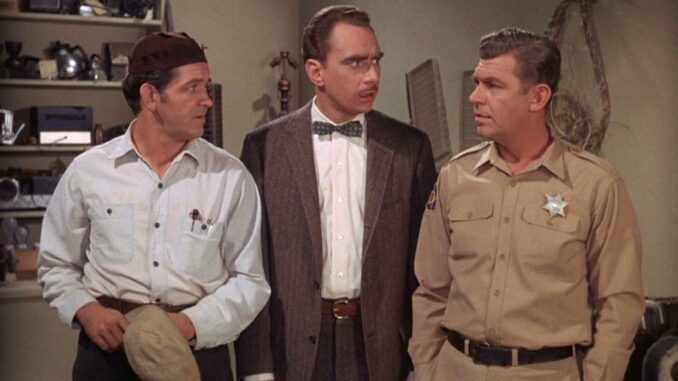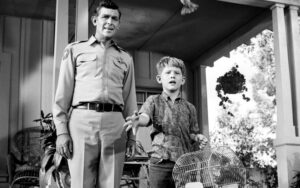
When you think about classic TV shows, one of the first that comes to mind is undoubtedly The Andy Griffith Show. Known for its down-to-earth humor, wholesome values, and iconic small-town setting, the show left an indelible mark on American television. But behind the scenes, things weren’t always as simple as they appeared on screen. Did you know that some scenes had to be filmed up to 20 times before they got it just right? In this article, we’ll dive into why the cast of The Andy Griffith Show sometimes needed so many takes to perfect a scene. From bloopers to the high standards set by the production team, we’ll uncover all the behind-the-scenes details that even die-hard fans may not know.
The Perfectionism Behind Classic TV
To understand why scenes on The Andy Griffith Show took so many takes, you first have to consider the environment of 1960s television. The show’s creator and star, Andy Griffith, and the entire cast took their craft seriously. While the show came across as light and easy-going, getting that perfect balance of humor and heart wasn’t always easy.
The High Standards of Andy Griffith Himself

Andy Griffith was more than just the star of the show—he was a perfectionist who wanted every scene to reflect the charm and values of Mayberry. If the timing of a joke wasn’t right or an emotional moment didn’t land perfectly, he wasn’t afraid to do it again—and again—until it was flawless.
Griffith’s commitment to excellence pushed the cast and crew to aim for the highest quality possible, which meant more takes to fine-tune their performances.
Comedy Timing: Getting It Just Right
Comedy is all about timing, and in a show like The Andy Griffith Show, where much of the humor was subtle, nailing that perfect timing was critical. Whether it was Don Knotts delivering a nervous Barney Fife line or Griffith reacting with his signature calm demeanor, the slightest slip-up could ruin a scene’s flow. As a result, actors often had to run through the same lines multiple times to ensure every word and pause hit exactly as intended.
The Challenges of Filming Live Audiences

Even though The Andy Griffith Show wasn’t filmed in front of a live studio audience, laughter and reactions from behind the camera were common. Often, the cast’s comedic moments were so good that the crew themselves couldn’t help but burst into laughter. Unfortunately, this meant ruining takes, which led to several retakes to get a clean, laugh-free shot.
Don Knotts: The Scene-Stealer and His Blooper Reel
One cast member who was notorious for requiring extra takes was Don Knotts, who played the bumbling deputy Barney Fife. His character was so hilariously exaggerated that even Knotts himself couldn’t keep a straight face at times. It wasn’t uncommon for Knotts to break into laughter mid-scene, forcing the director to call for multiple retakes. Yet, those extra takes ultimately contributed to the memorable performances that made Barney Fife such an iconic character.
The Complex Nature of Simple Scenes
While The Andy Griffith Show often revolved around the simple life in Mayberry, even the simplest of scenes could take time to perfect. Whether it was a heartfelt conversation between Andy and Opie or an ensemble scene involving many cast members, the dynamics required precision. The challenge was ensuring every line, gesture, and facial expression contributed to the narrative without feeling forced or unnatural.
Technical Difficulties: Why Perfection Wasn’t Just About Acting
It wasn’t just the cast’s performances that led to multiple takes—sometimes technical issues came into play. Filming in the 1960s wasn’t as advanced as it is today, so lighting, sound, and camera angles often required adjustment. If something was even slightly off, the scene had to be reshot. These minor technical details added to the number of takes needed to get each episode just right.
The Importance of Camera Angles and Blocking
One of the reasons why The Andy Griffith Show was so visually appealing was its use of clean, well-framed shots. Achieving this involved blocking, where actors needed to hit specific marks for camera angles to work correctly. If someone missed their mark or moved at the wrong time, the whole scene could fall apart visually, requiring a redo.
The Pressure to Maintain Consistency in Performance
Television acting requires consistency, especially when it comes to reactions and dialogue delivery. In some scenes, actors needed to maintain the same energy and emotion take after take. If one take was off in tone compared to the others, the editors would struggle to piece together a coherent scene, leading to retakes until the performance was just right.
Working with Child Actors: A Unique Challenge
Ron Howard, who played Opie, was a young actor during the filming of The Andy Griffith Show, and while he was exceptionally talented, working with child actors comes with its own set of challenges. Child actors can be unpredictable—they may forget lines, get distracted, or lose focus. These factors often contributed to the need for extra takes, though Howard himself was known for being remarkably professional for his age.
The Role of Improv and Spontaneity
Though The Andy Griffith Show followed a script, the cast was encouraged to play around with their lines and delivery. This spontaneity often led to unexpected moments of brilliance—but also occasional flubs. The balance between staying true to the script and allowing for improvisation sometimes resulted in additional takes to refine the final product.
Behind-the-Scenes Chemistry: Was It a Blessing or a Curse?
The cast of The Andy Griffith Show had incredible chemistry, and while this made for compelling on-screen relationships, it also meant they had fun behind the scenes. Sometimes, they would get carried away with inside jokes or laughter, causing retakes. While this camaraderie made filming enjoyable, it also slowed down the process at times.
The Pressure of Weekly Episodes
Keep in mind, The Andy Griffith Show was part of the golden age of television, where episodes were churned out on a weekly basis. This schedule didn’t allow for much room to breathe, so every minute of filming counted. Despite the pressure, the team was committed to creating a top-tier show, even if that meant retaking scenes multiple times to get them just right.
Conclusion: A Show Worth the Extra Effort
So, why did The Andy Griffith Show sometimes need 20 takes for a single scene? It came down to a combination of factors: the high standards of the cast and crew, the complexity of even simple scenes, technical challenges, and the natural human element that sometimes led to bloopers or distractions. In the end, though, the extra effort paid off. The show’s enduring legacy is a testament to the hard work that went into every episode. While it may have taken more time and patience to perfect each scene, the result was a timeless classic that continues to charm audiences to this day.
